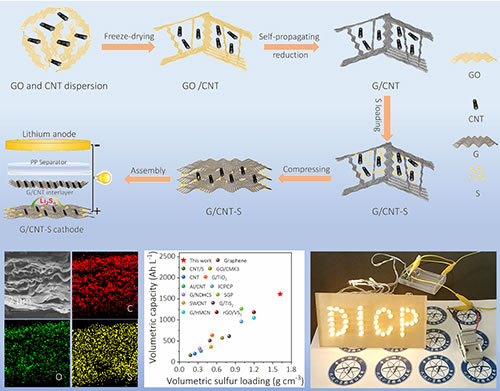
Recently, the team of Wu Zhongshuai, a researcher of the 2D Material and Energy Device Innovation Special Zone Research Group of Dalian Institute of Chemical Physics, Chinese Academy of Sciences, has developed a 3D graphene / carbon nanotube porous aerogel material and applied it to the sulfur of lithium-sulfur batteries The elementary carrier and the intermediate layer are integrated with the positive electrode to obtain a lithium-sulfur battery with high volume energy density and excellent cycle stability. Related research results were published in "Nano Energy" (Nano Energy).
Lithium-sulfur battery has high-quality theoretical energy density (2600Wh / kg) and high volume energy density (2800Wh / L), and is considered to be a very specific high-energy battery. However, due to the low mass density of sulfur element (2.07g / cm3), poor conductivity (5 × 10-30S / cm), large volume expansion of active material during charging and discharging (78.7%), and severe polysulfide shuttle, etc., As a result, although its mass density is high, the volume energy density is generally low and the cycle performance is poor, which greatly limits the practical application of lithium-sulfur batteries. Therefore, how to improve the quality and volume energy density of the lithium-sulfur battery at the same time, and extend its cycle life is one of the current bottlenecks in lithium-sulfur battery application research.
The research team developed a three-dimensional graphene / carbon nanotube porous aerogel material, and at the same time applied it to the sulfur element carrier and intermediate layer of lithium-sulfur batteries, successfully constructed a self-supporting, metal-free current collector integrated cathode material. The integrated cathode material has high compact density, excellent conductivity, and good mechanical flexibility. It not only achieves a high volume sulfur load (1.64g / cm3), but also significantly improves the volume energy density of the lithium-sulfur battery (1615Ah / L), and effectively inhibit the effect of polysulfide shuttle. Under the condition of a large current density of 2C, the battery was able to circulate stably for 500 cycles with almost no capacity decay, showing excellent cycle stability. This design strategy of the sulfur element carrier and the intermediate layer integrated cathode structure provides a new idea for the construction of lithium-sulfur batteries with high volume energy density and long cycle life.
The above work was supported by the National Natural Science Foundation of China and the National Key R & D Program.
Ebic Tools Limited , https://www.ebictools.com
